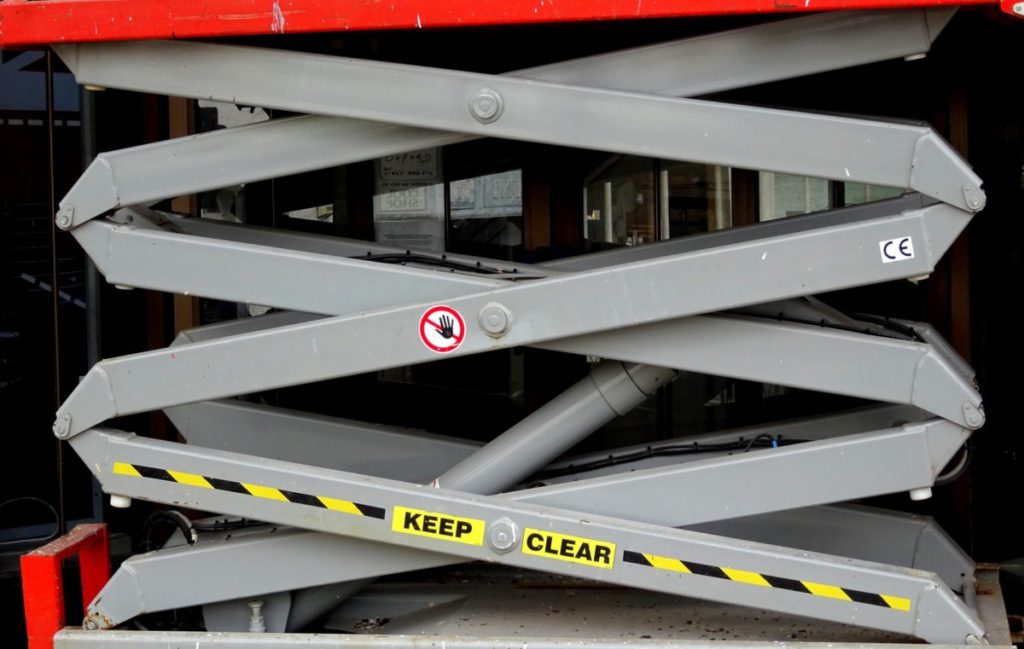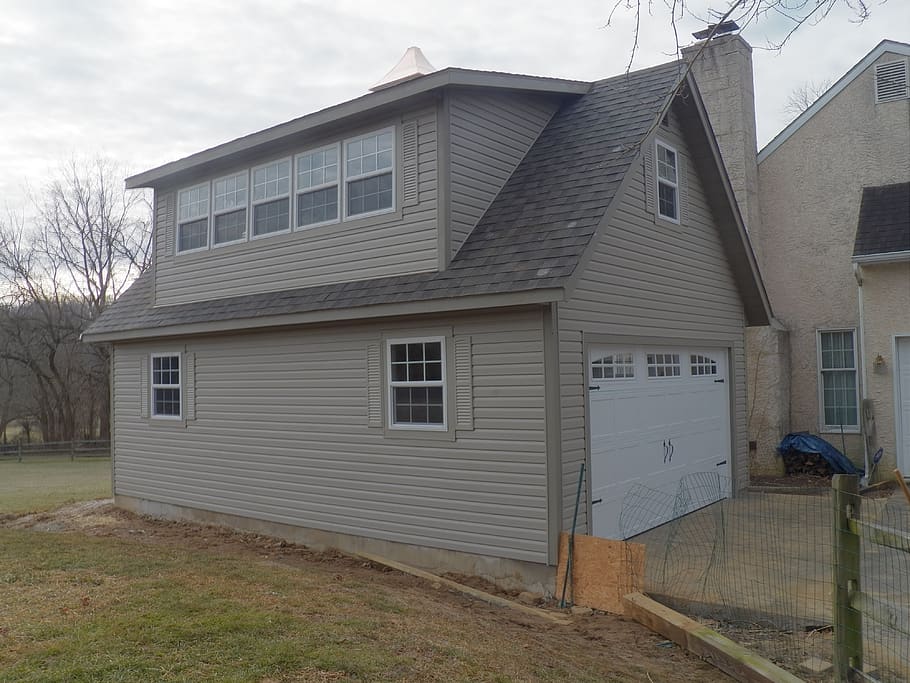In its prime, your garage was a sight to behold – siding that complemented the house, sparkly clean windows on the roll-up door, utilities expertly connected under the gable, roof tiles perfect. Now, your only image of that fine garage is a faded Polaroid photo that’s now nearly 50 years old. Today, your garage looks like it’s sinking into the clover in the backyard, the wood floor joists are rotten, and the walls are sagging. Can it be saved?
Can you raise a garage? You can raise a garage – carefully, with an eye to caution and a resolve to do everything that needs to be done while you have the garage lifted up. It’s a daunting task, but not an impossible one. It might be the only way to save your garage.
Garages are not held to the same construction standards as dwellings. Different materials, different load/support requirements, and different expectations for things like flooding, settling, termites and more make garages’ lifespan much less than the homes they share the property with. But since a garage is small – relative to the house – it’s more fixable when things go wrong.
Table of Contents
Symptoms of a Sick Garage

Houses settle. They sink into the ground. Not severely, of course, but it doesn’t take much for problems to show themselves, as with cracked drywall, doors that don’t close properly, bricks separating, cracks in masonry, and in broken window glass. Depending on the soil, a house can settle several inches over a 20-year period.
Garages settle as well, but often at a more alarming rate, in rare cases as much as three or four inches in just a few years. They do this for various reasons.
- The ground wasn’t compacted well enough.
- The foundation wasn’t adequate.
- The footings weren’t adequate.
- Water runoff undermined the soil.
- The soil composition did not provide enough support.
And, since garages aren’t part of the living quarters normally, there is a reduced sense of urgency to fix problems as they develop. The procrastination leads to a more rapid descent into the soil in many cases.
To a large degree, the symptoms are the same as with a house – cracks in the foundation (or in the case of garages, concrete slab floors), doors that no longer hang right, roll-up doors that get off track frequently, beams and joists that should be level but aren’t, water rolls to one side of the floor and creates puddles that don’t drain, etc.
Often, particularly perceptive individuals can just “sense” that things aren’t right. A settling or tilting garage can also be a trip hazard, as the floor buckles in places.
Technically, What Happened Here?
When a structure settles, whether it’s a house, garage, building, or the Leaning Tower of Pisa, it’s not really a situation where the foundation is forcing its way into the subsoil because it’s so heavy.
What really happens is that the subsoil – for whatever reason – has vacated in various places, and the foundations sags into the open areas. Now, we’re not talking about huge sinkholes or massive caverns opening up under the structure. Many times, it’s fractions of an inch. But any area where these anomalies occur is vulnerable to more of the same over time.
Where does the soil go? In most cases, the soil doesn’t go much of anywhere. It shifts and reconfigures itself into a more compact form. This is known as compaction and is responsible for the creation of unfilled pockets underneath the soil surface. These pockets need to be filled by something, whether it’s air, water, rocks, or more soil from above.
During certain times of the year, these cavities are filled with water, but as the soil dries out, the water disappears, leaving the cavity empty again. The cavity can remain open for a while, but eventually, it’s quite likely that the soil above it will fall into a hole, and therefore create a new hole above it, and the cycle repeats itself.
Subsidence
Subsidence is a term generally reserved for large scale movement of soil, usually due to the depletion of groundwater. In extreme cases, entire city blocks have been affected. Groundwater can be vacated by a number of conditions, some man-made.
On a smaller scale, naturally-occurring subsidence can cause your home or garage’s foundation to settle.
Fixing the Problem – Jacking up the Garage

There are several techniques that can be employed to fix foundation and flooring problems with garages. You will find a number of online videos and blogs that suggest that this would be a DIY project, but your first thought should be to contact a professional and decide from what you learn from him whether to try any of this yourself.
This is not a task for the faint-hearted!
Mudjacking
Detached and even attached garages can be repaired or refortified using a technique called mudjacking.
This technique is particularly useful for garages that have settled due to an abundance of hollow spaces – voids – under the slab floor. When the garage is lifted up, these voids can be filled, and the garage lowered back to its original elevation. This is the quick and simple fix, but unfortunately, this fixes only one of what could be multiple issues.
If your foundation wall is falling, and you have an attached garage, simply filling voids will not accomplish a permanent repair. You may need foundation piers installed to shore up the existing fortification.
It’s amazing, but garages can be raised along with their concrete slab floors in many cases. Factors that would prevent this technique include:
- Floors that are pitted.
- Floors that are badly cracked.
- Floors where the cracks are too close to the exterior walls.
Raising to a Higher, Permanent Elevation
In rare cases, sometimes a garage is so old, has subsided so far, or is in such a flood-prone location that it must be permanently lifted to a higher elevation.
In such extreme cases, the concrete floor cannot be saved. The floor can remain intact, but the outer perimeter must be broken out and removed so that the garage can be raised independently. To keep the outer walls supported during the lifting process, a ledger board should be installed all the way around, but it should not be a solid board, but several at the same height.
After either temporarily cross-bracing door and window openings (or deciding to replace the doors and windows) and rebracing any walls that may have bowed out or in during the settling process, the garage can be raised with construction grade floor jacks.
While the garage is up off the foundation, these things (and others, depending on your individual situation) should be done:
- Remove any rotten wood that will interfere with the foundation.
- Remove all debris from the worksite.
- Dig trenches for new footers.
- Build the forms for the new concrete with plywood, and add sufficient (here’s a case where more is better) runs of 5/8s-inch rebar.
- Fill in any voids in the subsoil.
- Pour the concrete. Wait 24-48 hours before lowering the garage back onto its new foundation.
Preventative Measures

When a house is built on a lot, the house gets top priority, when it comes to excavating, leveling and compacting the soil. Soil lying outside the perimeter of the house’s footprint doesn’t get nearly as much attention.
Unfortunately, free-standing garages, especially if they’re built after the house has been sold, are often built on soil that wasn’t really prepared for structure support. If you haven’t built a garage yet, you have an excellent opportunity to make the conditions right before you do build. Professional excavators know the regulations for soil prep and can be relied on to get your future garage site in good shape before the first footer is poured.
If your garage is at the bottom of a slope, that could mean you will have problems with erosion or undermining. Try diverting water away from the garage and observe how the water behaves after – or even during – a hard rain.
Rain gutters are valuable aids against foundation flooding. It’s a major reason homes have basement flooding and a significant reason why garages have sinking foundations. Rain gutters should ideally empty into drain pipes, but if not drain pipes, then splash blocks that redirect the water away from the foundation.



0 Comments